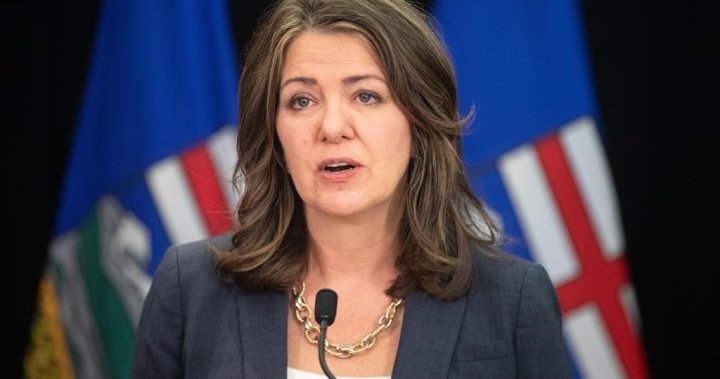As many parts of Canada reeled under hot weather, a group representing migrant farm workers wrote a letter to Ontario premier Doug Ford on Monday, urging him to put protections in place for those toiling in the fields.
“Farmworkers are 35 times more likely than the general public to die of heat exposure. The province should not wait for a tragedy to happen before it passes legislation to protect the foundation of Canada’s food system: farm workers,” Chris Ramsaroop, organizer with the group Justice for Migrant Workers, wrote in his letter to Ford.
The group referenced a 2022 statement by the Ontario Human Rights Commission, which established access to cooling as a human right.
“Access to cooling during extreme heat waves is a human rights issue. As temperatures rise due to climate change, extreme heat waves have and will continue to disproportionately impact groups protected under Ontario’s Human Rights Code,” the commission said.
Andrew Gage, lawyer at the West Coast Environmental Law Association, said, “It’s (the right to cooling) a proactive right that someone needs to act on.”
Blair Feltmate, head of the Intact Centre for Climate Adaptation at the University of Waterloo, said, “It makes perfect sense that we treat access to cooling as a fundamental human right, the same way we think of access to warmth in winter as a fundamental human right to keep people from freezing to death or suffering unduly.”
Feltmate said certain groups are especially vulnerable. These include the elderly, people with pre-existing health issues or those with limited financial means. These groups are likely to not have access to air conditioning or experience social isolation.
He said the B.C. heat dome of 2021, in which 619 people were killed due to extreme heat, is an example of just how destructive heat waves can be. Feltmate also cited the UN Universal Declaration of Human Rights, which lays out “the right to a standard of living adequate for the health and well-being.”
Cities across Canada are now seeing mobilization of tenants and workers for greater rights during heat waves. On Thursday, groups in Edmonton held a demonstration demanding maximum temperature requirements in apartment buildings.
Breaking news from Canada and around the world
sent to your email, as it happens.
This comes soon after several organizations in Toronto banded together to form Toronto Heat Safety, a new coalition of tenant advocacy and environmental organizations.
A recent StatCan report suggested cities with more renters have higher risks of extreme heat deaths.
Feltmate said cities can heat up a lot faster than rural areas.
“If we had an extreme heat event combined with an elongated electricity outage (in Toronto), people would die in the thousands very very quickly. We’re not prepared,” he said.
Toronto Heat Safety has called on the city to implement bylaws that limit temperatures inside residential buildings to no higher than 26ºC.
The Canadian Environment Law Association (CELA) is part of the coalition. CELA lawyer Jacqueline Wilson told Global News, “26 degrees as an indoor temperature is really where you start to see this escalation of health impacts that need to be addressed.”
She said the coalition is focusing on pushing through maximum temperature by-laws, which would be enforceable in the same ways as minimum temperature requirements in the winter. She said these laws would put the onus on landlords, instead of on tenants, to keep apartments cool.
“The responsibility is certainly not on tenants and in particular, low-income tenants who are disproportionately impacted by the climate crisis, who aren’t responsible for it and are left in these situations with few ways to address the extreme heat in their units,” she said.
Juan Vargas with Climate Emergency Unit in Edmonton said, “It was really important to build a campaign that spoke exactly to those experiences of people who are honestly falling through the cracks right now and (those are) tenants.”
Feltmate said passive cooling mechanisms should be relatively cheap for landlords to install. These include glazing on windows to limit heat build-up inside apartments, installing large awnings over balconies and windows to keep the sunlight out, installing roof vents to let the hot air out and planting and having more shade trees around buildings.
But cities, too, can make some changes.
“Other things you can do on a larger scale to affect cooling are painting roofs white, literally called cool roofs. When sunlight hits a bright colored roof or white colored roof, most of the energy reflects into space,” he said.
But Canadian summers are getting warmer and passive cooling may not be enough, experts say. Climate modelling suggests that by the 2040s, the number of days where the temperature exceeds 30 degrees Celsius will grow from 20 days currently to 66 days every year.
On Tuesday, scientists at Environment and Climate Change Canada said the above-normal temperatures experienced in Ontario, Quebec and Atlantic Canada in June were made two to 10 times more likely as a result of human-caused climate change.
Feltmate said some of the most vulnerable Canadians will need access to air conditioners and heat pumps if they aren’t able to afford it.
“To have a 5,000 BTU air conditioner, which could cool a room of 250- to 300-square-feet quite easily, the cost is about $150, and that air conditioner would last on average about 10 years, which means $15 per summer,” he said.
He added that additional protections will be need to put in place for people like farm workers and gig workers who work outdoors and people who don’t have a home.
“We need to make sure that people with preexisting health conditions that are cardiac or respiratory in nature, are not in those conditions, he said.
He said that certain professions, such as construction and agriculture, might have to start considering time of day requirements.
“For people who work on roofing houses or paving driveways, they should be starting as early in the morning as possible and then perhaps end their work by noon that day,” he said.
Employers also need to ensure outdoor workers have access to cool rooms and get enough breaks to stay cool and hydrated, he said.
While some groups are pushing for legislative reforms, others are taking the fight to large oil corporations. In June 2022, a year after extreme climate events devastated British Columbia, the West Coast Environmental Law Association started the ‘Sue Big Oil’ campaign.
Gage, a lawyer with the group, said, “2021 was a wake-up call in B.C., where we had the heat dome in which more than 600 people died. We had flooding, we had wildfires, Lytton burned down. It was a huge wake-up call.”
He said it was time to take the fight to the corporations that have been most responsible for much of the world being locked in on a fossil fuel economy.
“The oil and gas industry knew by the ’70s and the ’80s that these types of impacts were going to be the direct result of the continued burning of their products,” he said.
Gage said nine local governments in B.C. have already pledged to work towards a giant class action lawsuit to get big polluters to pay for climate mitigation and adaptation. The campaign is expecting to get more to sign on.
“The alternative is that taxpayers are on the hook for 100 per cent of the cost,” he said.
Feltmate said the cost of not acting to adapt our lives to the changing climate will be far more than the cost of adapting.
“The mobilization of adaptation is not as expensive as people think. Generally speaking, it’s a one-time upfront cost, and then you realize the benefits of that upfront cost almost in perpetuity,” he said, “It’s the gift that keeps on giving.”




